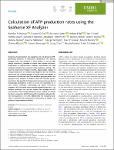Calculation of ATP production rates using the Seahorse XF Analyzer
| dc.contributor.author | Desousa, BR | |
| dc.contributor.author | Kim, KKO | |
| dc.contributor.author | Jones, AE | |
| dc.contributor.author | Ball, AB | |
| dc.contributor.author | Hsieh, WY | |
| dc.contributor.author | Swain, P | |
| dc.contributor.author | Morrow, DH | |
| dc.contributor.author | Brownstein, AJ | |
| dc.contributor.author | Ferrick, DA | |
| dc.contributor.author | Shirihai, OS | |
| dc.contributor.author | Neilson, A | |
| dc.contributor.author | Nathanson, DA | |
| dc.contributor.author | Rogers, GW | |
| dc.contributor.author | Dranka, BP | |
| dc.contributor.author | Murphy, AN | |
| dc.contributor.author | Affourtit, C | |
| dc.contributor.author | Bensinger, SJ | |
| dc.contributor.author | Stiles, L | |
| dc.contributor.author | Romero, N | |
| dc.contributor.author | Divakaruni, AS | |
| dc.date.accessioned | 2023-08-08T11:04:28Z | |
| dc.date.available | 2023-08-08T11:04:28Z | |
| dc.date.issued | 2023-10-09 | |
| dc.identifier.issn | 1469-221X | |
| dc.identifier.issn | 1469-3178 | |
| dc.identifier.other | ARTN e56380 | |
| dc.identifier.uri | https://pearl.plymouth.ac.uk/handle/10026.1/21182 | |
| dc.description.abstract |
Oxidative phosphorylation and glycolysis are the dominant ATP-generating pathways in mammalian metabolism. The balance between these two pathways is often shifted to execute cell-specific functions in response to stimuli that promote activation, proliferation, or differentiation. However, measurement of these metabolic switches has remained mostly qualitative, making it difficult to discriminate between healthy, physiological changes in energy transduction or compensatory responses due to metabolic dysfunction. We therefore present a broadly applicable method to calculate ATP production rates from oxidative phosphorylation and glycolysis using Seahorse XF Analyzer data and empirical conversion factors. We quantify the bioenergetic changes observed during macrophage polarization as well as cancer cell adaptation to in vitro culture conditions. Additionally, we detect substantive changes in ATP utilization upon neuronal depolarization and T cell receptor activation that are not evident from steady-state ATP measurements. This method generates a single readout that allows the direct comparison of ATP produced from oxidative phosphorylation and glycolysis in live cells. Additionally, the manuscript provides a framework for tailoring the calculations to specific cell systems or experimental conditions. | |
| dc.format.extent | e56380- | |
| dc.format.medium | Print-Electronic | |
| dc.language | en | |
| dc.publisher | EMBO | |
| dc.subject | ATP | |
| dc.subject | ECAR | |
| dc.subject | glycolysis | |
| dc.subject | oxidative phosphorylation | |
| dc.subject | Seahorse XF Analyzer | |
| dc.title | Calculation of ATP production rates using the Seahorse XF Analyzer | |
| dc.type | journal-article | |
| dc.type | Article | |
| plymouth.author-url | https://www.ncbi.nlm.nih.gov/pubmed/37548091 | |
| plymouth.issue | 10 | |
| plymouth.volume | 24 | |
| plymouth.publisher-url | http://dx.doi.org/10.15252/embr.202256380 | |
| plymouth.publication-status | Published | |
| plymouth.journal | EMBO reports | |
| dc.identifier.doi | 10.15252/embr.202256380 | |
| plymouth.organisational-group | |Plymouth | |
| plymouth.organisational-group | |Plymouth|Research Groups | |
| plymouth.organisational-group | |Plymouth|Faculty of Health | |
| plymouth.organisational-group | |Plymouth|Research Groups|Institute of Translational and Stratified Medicine (ITSMED) | |
| plymouth.organisational-group | |Plymouth|Research Groups|Institute of Translational and Stratified Medicine (ITSMED)|CBR | |
| plymouth.organisational-group | |Plymouth|REF 2021 Researchers by UoA | |
| plymouth.organisational-group | |Plymouth|Users by role | |
| plymouth.organisational-group | |Plymouth|Users by role|Academics | |
| plymouth.organisational-group | |Plymouth|REF 2021 Researchers by UoA|UoA03 Allied Health Professions, Dentistry, Nursing and Pharmacy | |
| plymouth.organisational-group | |Plymouth|Faculty of Health|School of Biomedical Sciences | |
| dc.publisher.place | England | |
| dcterms.dateAccepted | 2023-07-14 | |
| dc.date.updated | 2023-08-08T11:04:17Z | |
| dc.rights.embargodate | 2023-8-9 | |
| dc.identifier.eissn | 1469-3178 | |
| dc.rights.embargoperiod | forever | |
| rioxxterms.versionofrecord | 10.15252/embr.202256380 |


